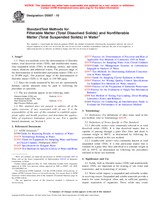We need your consent to use the individual data so that you can see information about your interests, among other things. Click "OK" to give your consent.
ASTM D5907-10
Standard Test Methods for Filterable Matter (Total Dissolved Solids) and Nonfilterable Matter (Total Suspended Solids) in Water
STANDARD published on 15.5.2010
The information about the standard:
Designation standards: ASTM D5907-10
Note: WITHDRAWN
Publication date standards: 15.5.2010
SKU: NS-33043
The number of pages: 9
Approximate weight : 27 g (0.06 lbs)
Country: American technical standard
Category: Technical standards ASTM
Annotation of standard text ASTM D5907-10 :
Keywords:
dissolved matter, filterable matter, nonfilterable matter, suspended matter, total dissolved solids, total suspended solids, Dissolved elements (of water), Drinking water, Filters/filter procedures--water testing, Industrial water treatment, Nonfilterable matter, Surface water, Suspended matter, Trace elements--water analysis, ICS Number Code 13.060.60 (Examination of water for physical properties)
Additional information
| Significance and Use | ||||||||||||||||||||||||||||||
|
Solids, both as filterable matter (TDS) and nonfilterable matter (TSS), are important in the treating of raw water and wastewater, and in monitoring of streams. Waste solids impose a suspended and settleable residue in receiving waters. Suspended and soluble materials provide a matrix for some biological slime and, in sufficient quantity, impair respiration of organisms. These solids may create nuisance slime beds and odors while imposing a long-term biological oxidation load over limited receiving water areas. Knowledge of suspended and soluble materials is important in treating raw water supplies. Knowledge of solids loading can aid in determining the type or amount of treatment, or both, necessary to make the water acceptable for use. Such information may also be used to determine acceptability of water after treatment. Too little treatment may not be desirable and excess treatment costs money. Stream monitoring is important for environmental reasons, such as compliance with discharge permits. Stream improvements, water pollution monitoring, mass wasting, algal studies, and sediment loads are but a few of the many reasons streams are monitored. |
||||||||||||||||||||||||||||||
| 1. Scope | ||||||||||||||||||||||||||||||
|
1.1 These test methods cover the determination of filterable matter, total dissolved solids (TDS), and nonfilterable matter, total suspended solids (TSS), in drinking, surface, and saline waters, domestic and industrial wastes. The practical range of the determination of nonfilterable particulate matter (TSS) is 4 to 20 000 mg/L. The practical range of the determination of filterable matter (TDS) is 10 mg/L to 150 000 µg/g. 1.2 Since the results measured by this test are operationally defined, careful attention must be paid to following the procedure as specified. 1.3 The test methods appear in the following order:
1.4 This standard does not purport to address all of the safety concerns, if any, associated with its use. It is the responsibility of the user of this standard to establish appropriate safety and health practices and determine the applicability of regulatory limitations prior to use. For a specific hazard statement, see Section 8. |
||||||||||||||||||||||||||||||
| 2. Referenced Documents | ||||||||||||||||||||||||||||||
|
We recommend:
Technical standards updating
Do you want to make sure you use only the valid technical standards?
We can offer you a solution which will provide you a monthly overview concerning the updating of standards which you use.
Would you like to know more? Look at this page.




 Cookies
Cookies
